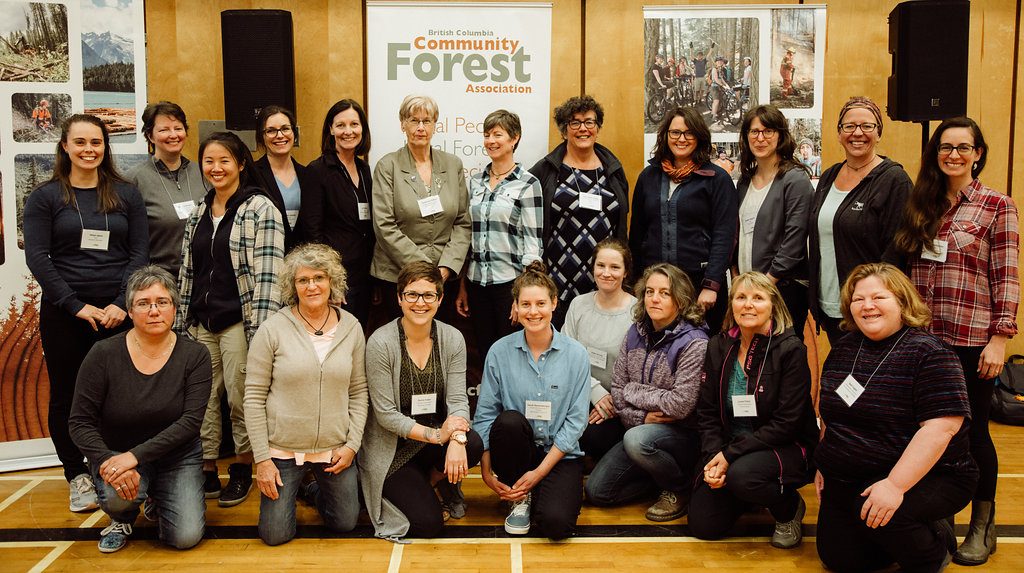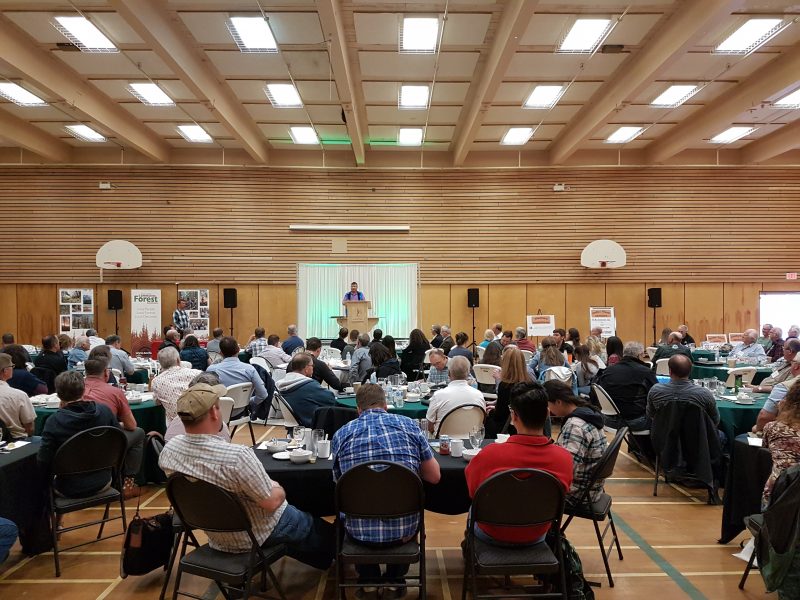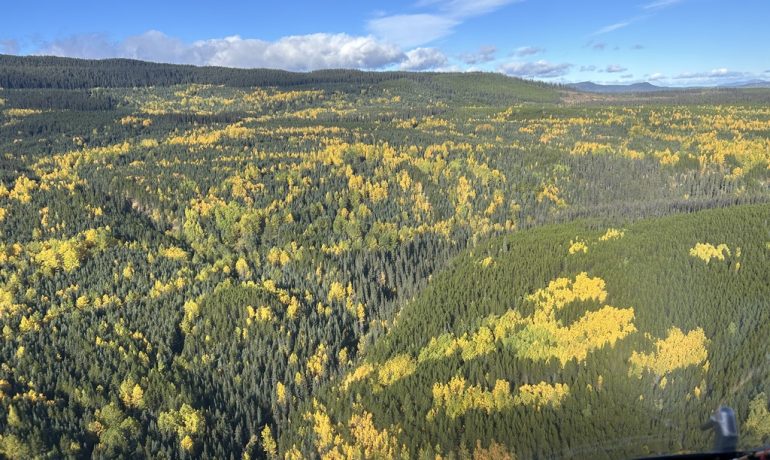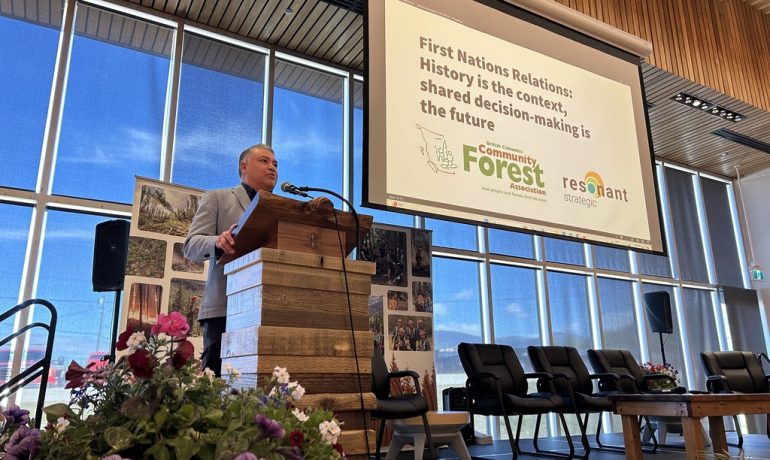Host Communities Field Trip Day
Burns Lake Community Forest – Frank Varga, RPF, General Manager
“BLCF was initiated in 2000, same year MPB epidemic exploded. Entire history has been reactive, first MPB control, then salvage. To a great degree, MPB has been ‘in charge’ of BLCF management. All that BLCF and ministry staff have known is reacting to MPB. MPB salvage program will end in the next few years. Board recognizes this as a major turning point in history of BLCF. The nature of the turning point can be described as: BLCF has been managed as if it were part of the Lakes TSA. This was OK while we reacted to MPB epidemic. Problem is we had to forego advantages of area-based tenure. Going forward, BLCF and ministry staff must think and act in ways that unlock potential of area-based tenure. Need to implement a new vision and objectives to create change. “
Chinook Community Forest – Ken Nielsen, General Manager
The Chinook Community Forest has an AAC of 150,000 cubic meters per year for the first three years. The AAC drops to 63,000 cubic meters per year for the last two years of the five-year cut. In 2021 they will perform an AAC calculation to determine its long-term AAC.
Using Lidar To Evaluate Old-Growth Attributes in OGMAs – Luizmar de Assis Barros M.S.c. of Natural Resources and Environment Studies, UNBC
Research Question: Are OGMAs in the Chinook Community Forest retaining old-growth attributes?
Session 1 – Ministry of Forests, Lands, Natural Resource Operations and Rural Development (MFLNRORD) Engagement Reports and New Priorities
Shane Berg, Deputy Chief Forester of BC, and Executive Director, Office of the Chief Forester, MFLNRORD
“What I saw yesterday during the field trip was a forest community being innovative. I saw partnerships with Industry making use of the resource in a manner not commonly seen across the province. I saw improbable utilization…some piles didn’t look like they’d make firewood. And most importantly, I saw partnerships with First Nations…strengthening the common interests in practicing good forest stewardship…and sharing in the benefits of what the community forests can offer.”
Report on the 2017 Flood & Fire Review –Ian Meier, Director of Operations, BC Wildfire Service
“Eight CFAs were impacted by wildfire last year, totaling 25 000 ha which is an awful lot of hectares to burn in the CFA context. There is funding out there! Think, rehab and wildfire restoration projects.” Chief Maureen Chapman and George Abbott’s recently released report, “Addressing the New Normal: 21st Century Disaster Management in British Columbia” includes 108 recommendations.
Rural Development Review – Marc Imus, MFLNRORD Regional Economic Operations Branch Kamloops, Director, Southern Interior Region
Following the Rural Engagement process, the “What We Heard” report will be released Spring 2018. “We see so much potential for Community Forests.”
Modernized Land Use Planning and Managing for Multiple Values – Kevin Kriese, ADM Regional Operations, North Area, MFLNRORD (No PowerPoint)
Kevin spoke to the new, modernized approach to Land Use Plans (LUP). The new approach will be specific and consider the issue that needs to be solved or what needs to be reflected differently in current LUPs. The new approach must also consider the changing dynamics of a changing climate, be data driven and include accumulative assessments. Processes will be co-designed with First Nations. “LUP is often a call for a conversation.”
Session 2 – BCCFA Major Projects Update
The Year in Review – Jennifer Gunter, Executive Director, BCCFA
“There is a need for a stronger role for CFAs in land stewardship and management. 2017 has shown the important role of community forests in mitigating natural disasters. CFAs might be the “best tools we have in the toolbox” to address these issues because we put Indigenous peoples and wildfire management in the focus.”
“Building Relationships and Cultivating Social Licence – A Guide for Small Tenure Holders In BC” – Susan Mulkey, BCCFA
BCCFA’s new extension guide was developed for managers of small tenures in BC. Building social licence is a continuum. It’s a range of engagement strategies, supplements to legal requirements for license of small tenure holders. We observed: “providing busses for seniors in communities are not enough to build social licence. These activities are transactional. Social license needs more. It’s about building strong relationships.”
Session 3 – Land Based Investments Panel
Overview of land based investment funds and objectives – Doug Stewart, Director, Forest Tenures Branch, MFLNRORD
“New provincial Forest Carbon Initiative – BC has greenhouse gas reduction targets and forestry needs to play a role in this reduction. Funding is available through FESBC for activities incremental to regular business. Projects must meet costs per ton targets and be verified to reduce greenhouse gas emissions.”
Site Restoration and Reforestation – Neil Hughes, Forest Establishment Leader, Resource Practices Branch, MFLNRORD
“Because we can only address a percentage of what is required, we need to prioritize. The tools are better today, which can help us to do an assessment to determine what type of stands we should be treating. Where is the economic opportunity, and what are we going to be left with when there is no longer value in a stand to treat them? Where are the stands that we need to treat, what is economically feasible to harvest, and where are the stands that are not feasible to harvest, and how will those serve other non-timber values in the future?”
Forest Enhancement Society of BC (FESBC) – Gord Pratt, FESBC Operations Manager
“FESBC is a relatively new society: reducing GHGs, reducing wildfire risk, improving habitat are key goals. We are also advocates for good stewardship on the land base. Staff role: We are technical advisors, as well as your sales people. If you convince us, we convince our board for you. Finite funding: Treatment, more so than planning is our focus. Carbon projects have priority for next 4-5 years. Applicants must demonstrate social license in your application.”
Session 4 – Indigenous Relations and Building Social License
Linda Robertson, Regional Manager, Skeena Ministry of Indigenous Relations and Reconciliation
“We must move beyond the legalistic approaches with First Nations, focusing on transactions such as compensation for rights and title. Focus should be on shared values and relationships that foster self-determination. We must build relationships outside project transactions, and work across sectors (industry, government, community) to achieve this. CFAs are all about partnerships and values. They lead this call for innovative types of partnerships.”
Lisa Ambus, Project Leader, North Region Negotiating Team, Ministry of Indigenous Relations and Reconciliation (No PowerPoint)
“It is good to hear that 50 percent of CFAs are held by FNs or have at least collaboration. But in terms of where we have come from, there is a significant gap. The CFA is an opportunity to put core principles of reconciliation into action. What can you bring to this? What can you be doing to advance reconciliation with FNs? Every CFA should engage with those questions.”
Unlocking your Social Licence – Improving How We Engage Casey Macaulay, RPF, Association of BC Forest Professionals
“Where does trust come from? Trust is between people first. If people trust you, they may or may not choose to trust your organization too. Agreements are made by people and people have long memories. You can do everything legally correctly and still fail to gain trust. The effort to regain trust is far more difficult than establishing it in the first place.”

Forestry has historically been a profession dominated by men.
But if the 2018 BCCFA event is any indicator, there is a new trend building.
The conference drew a strong, very engaged cohort of great women.
Session 5 Wildfire – Science, Risks and Management Panel
Brian McNaughton, BC Federation of Woodlot Association, General Manager
“We must better govern our use of fire, and work on fire mitigation. We must increase forest health and rethink our management paradigm. We need to get deciduous trees back in the forests!” Brian shared his first-hand experience as an evacuee from the 2017 fires in the Cariboo.
Lori Daniels, Professor, UBC Department of Forest and Conservation Sciences
Community Wildfire Prevention Summary Report May 2018
Wildfires of 2017 cannot be another “wake-up call”. BC’s forests and communities are not resilient to wildfire and climate change. Transformative change is urgently needed. Surface fires + fire exclusion + fuel buildup = reduced resilience. State of emergency is the new reality. BUT these events are not beyond our control. We can effectively engage in fuel management. “We need to manage fuels as a form of adaptation.”
Stephan Martineau – Manager of SIFCo – the Slocan Integral Forestry Co-Op, in the Slocan Valley
Stephan Martineau #Part 1 Stephan Martineau #2
“Maps have a great function for public buy-in. Map fire risk and proximity to individual homes to raise awareness.”
Bruce Blackwell RPF, RPBio, BA Blackwell and Associates
Of the top 20 BC communities at risk from wildfire, 13 have community forests. “Fuel is the only thing we can affect when it comes to fire. If we don’t start doing prescribed fires, we will have no chance to come to terms with the new hazards around wildfire. Landscape level fuel breaks installation and prescribed burning will help to shift from high crown fires to low stand-level fires – should be the priority system. We can no longer attack the head of the fire in BC”.
Related Post
Forest Investment Program (FIP)
Forest Investment Program (FIP) The Forest Investment Program 2025/26
2024 Conference Presentations & Wrap Up
Conference Presentations and Videos in order of delivery



